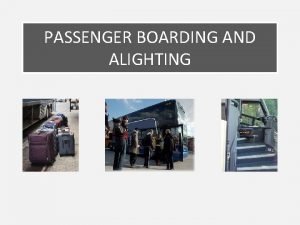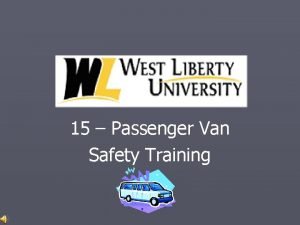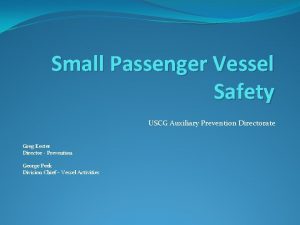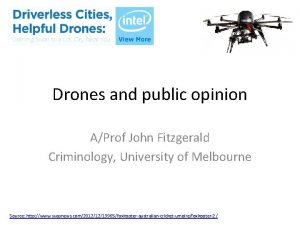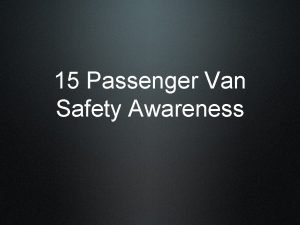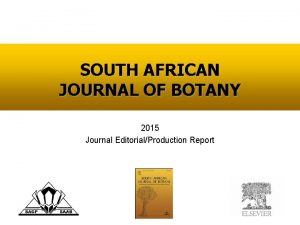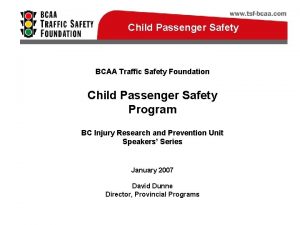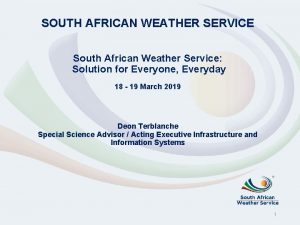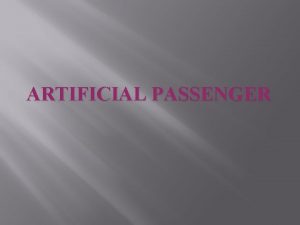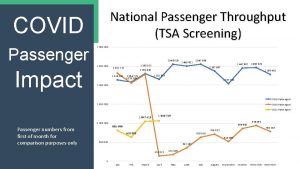SOUTH AFRICAN SAFETY CULTURE IN CHILD PASSENGER SAFETY











- Slides: 11

SOUTH AFRICAN SAFETY CULTURE IN CHILD PASSENGER SAFETY Safekids World Wide Injury Prevention Conference Date: Thursday, 20 June 2013

CONTENTS • BACKGROUND • THE CURRENT STATUS • LEGISLATION • THE PROBLEM • THE SOLUTION 2

SOUTH AFRICA – THE DYNAMICS Population: 51. 8 million Income Group: Middle Gross national income per capita: R 2 751 Mortality rate: 28/100 000 pn INSTITUTIONAL FRAMEWORK Lead Agency Funded in national budget Road Traffic Management Corporation Yes National road safety strategy Measurable targets Funded Under Review Developed Yes NATIONAL LEGISLATION RTMC ACT NRTA -seatbelt legislation 3 Yes, but does not enforce use of child restraint

SOUTH AFRICA-THE DYNAMICS u. SA a fledging democracy with unique challengesqsocio-economic q q Multi-cultural, multi-religious society q Eleven official languages q. Varying levels of literacy q. Poorly developed public transport, Scholar transport infrastructure üMajority transported in informal public transport over long distances ü 80% of population rely on public transport üMajority walk lonf distances to school o. Crossing major/arterial routes

CURRENT STATUS • More than 12 000 fatalities p/a • Cost of road injuries/fatalities is approx R 306 billion p/a • Very few awareness programmes on CPS • Long journeys/peak traffic season: ü roughly 65% of front seat ü less than 2% of rear passengers • Stats for shorter, local journeys even more dismal. üMost fatal crashes happen 40 km from home

CURRENT STATUS q. Affluent and literate families most likely to use child restraints q. Less affluent mainly use informal public transport in the form of minibus taxis and pick-up trucks which are likely to be overloaded q. Child restraints ranges between R 500 -R 3000

LEGISLATION NATIONAL ROAD TRAFFIC ACT, 93 of 1996 • The seatbelt legislation under regulation 213 • An adult is a person over the age of 14 years or taller than 1. 5 m and • A child is a person between the age of 3 years and 14 years, except if taller than 1. 5 m `no legal requirement for child > 3 yrs to wear child restraint The driver of a motor vehicle shall ensure that a child uses an appropriate child restraint; or wears the seatbelt if an unoccupied seat which is fitted with a seatbelt is available. BUT WHERE THERE IS NO SEAT WITH A SEATBELT, THE DRIVER SHALL ENSURE THAT THE CHILD IS SEATED ON THE REAR SEAT, (IF THE VEHICLE IS EQUIPPED WITH SUCH A REAR SEAT!! )

THE PROBLEM? Traffic mix does not allow for usage of child restraints `Little or no enforcement of correct seating position and use of child restraints(2/10) `Law enforcers not examplary `ambuiguity about enforcement of safety measures `very few awareness programmes Non compliance to rules and regulations `inadequate restraint laws for children `not necessary for short distance mentality `wont get a ticket-will bribe `age appropriate child restraint not used Lack of examplary behaviour by parents `Adults don’t buckle up `poor adherence to basic safety measures

THE PROBLEM? Personal choice not to use child restraints `child seats too much of a hassle `indifference of drivers to ensure the safety of passengers `children don’t like restraints “Act of love” `children on parents laps `children on the drivers laps `children assisting with driving Socio-economic situation `High unemployment rate and poverty `Usage of public transport to travel `Large families- therefore not practical to use child restraints `Bakkies-Vans used as passenger transport esp-rural areas

THE SOLUTION Enforcement Engineering Integrated approach Environmental modifications 10 Education

Contact details of presenter: Ms Mampe Kumalo A/Executive Manager: Road Safety Education and Campaigns Road Traffic Management Corporation South Africa (+27) 071 485 4784 (+27) 012 999 5313
